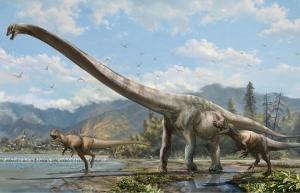New species of 160m yr old long-necked dinosaur discovered in China
 Washington, Jan 29 - Paleontologists have discovered new species of a skeleton of a long-necked dinosaur in China, which lived 160 million years ago.
Washington, Jan 29 - Paleontologists have discovered new species of a skeleton of a long-necked dinosaur in China, which lived 160 million years ago.
The species found by scientists from the University of Alberta paleontologists including PhD student Tetsuto Miyashita, former MSc student Lida Xing and professor Philip Currie, called Qijianglong (pronounced 'CHI-jyang-lon') is about 15 metres in length and lived in the Late Jurassic.
The name means " dragon of Qijiang," for its discovery near Qijiang City, close to Chongqing. The fossil site was found by construction workers in 2006, and the digging eventually hit a series of large neck vertebrae stretched out in the ground. Incredibly, the head of the dinosaur was still attached.
Miyashita said that it was rare to find a head and neck of a long-necked dinosaur together because the head is so small and easily detached after the animal dies.
The species belongs to a group of dinosaurs called mamenchisaurids, known for their extremely long necks sometimes measuring up to half the length of their bodies. Most sauropods, or long-necked dinosaurs, have necks only about one third the length of their bodies, but Qijianglong had neck vertebrae that were filled with air, making their necks relatively lightweight despite their enormous size. Interlocking joints between the vertebrae also indicate a surprisingly stiff neck that was much more mobile bending vertically than sideways, similar to a construction crane.
Mamenchisaurids are only found in Asia, but the discovery of Qijianglong reveals that there could be as many differences among mamenchisaurids as there are between long-necked dinosaurs from different continents.
The Qijianglong skeleton is now housed in a local museum in Qijiang.
The findings are published in the Journal of Vertebrate Paleontology. (ANI)